First, let’s keep it clear—this isn’t just a “pulley with teeth” for your Lifan 520. It’s the
engine’s “timing coordinator” , a precision-machined metal component at the heart of the 520’s LF479Q1 engine’s timing system. Mounted on either the camshaft (top) or
crankshaft (bottom), it works with the timing belt to sync two critical
engine parts: the crankshaft (which moves the pistons) and the camshaft (which opens/closes the valves). Think of it as the “link” that keeps everything on beat—its main jobs are to stop the pistons and valves from colliding (a disaster for engines), pass power from the crankshaft to the camshaft, and keep the engine’s timing accurate (so it runs smoothly, uses fuel efficiently, and avoids misfires). Without it, your 520’s engine would misfire, lose power, or even seize up entirely.
What is this pulley suitable for? (Why the wrong pulley can ruin your engine!)
This LF479Q1-1025012 pulley is only suitable for Lifan 520 engines equipped with LF479Q1. If you press the wrong button, your engine will malfunction. It's as simple as that.
What exactly is it suitable for
It matches the camshaft/crankshaft size, the number of teeth on the timing belt, and even the small notches aligned with the shaft (referred to as keyways). Check your identification code again. It's 100% certain.
Unsuitable things - Don't even try them!
Lifan 520 and other engines (such as LF475Q) : Different shaft dimensions and mismatched belt teeth. It won't attach correctly, and you'll never find the right moment.
Other Lifan models (such as the X60 or 620) : Their engines have completely different timing Settings. This pulley is either too big or too small, or the tooth spacing is incorrect - it's completely useless.
It's not a Lifan car: Even if they look very similar, the size of the wheels and the notches in the keyways are different. You will eventually get a complete timing mess, and you might even damage the shaft.
Installation and Maintenance - For professionals only! If time fails, it will fail
Installation: You can't do it yourself - find a certified Lifan technology
It takes perfect time to install this pulley - if you try to do it yourself, you'll ruin your 520's engine. The following is what professionals do:
First, prepare the engine: They remove the timing cover, loosen the old timing belt, and mark the original pulley seat (so they keep the timing track).
Remove the old pulley: They use a special pulley tool to slide the old pulley off the camshaft or crankshaft. Pulling hard will cause the shaft to bend - this is bad news.
Install the new pulley: They align the keyway of the new pulley with the small snap on the shaft, slide it, and then tighten the center bolt as Lifan said. If it's too tight, it will break. If it's too loose, it will slip off. There won't be any in the middle.
Fixed timing and testing: They put the timing belt back, use tools to ensure that the teeth of the pulley are aligned with the belt and the engine marking, and then start the engine. They will check for crackling or strange sounds to ensure it is correct.
Take good care of it - replace it before it breaks!
Check if there are any worn teeth (round or broken teeth can cause slipping) or cracks (heat can split metal).
When replacing the timing belt: When replacing a new timing belt (usually every 60,000 to 80,000 kilometers), be sure to replace the pulleys. The new belt on the old pulley wears out very quickly.
Do not use cheap belts: Only use timing belts with this pulley that are approved by Lifan. Ordinary ones have mismatched teeth that damage the grooves of the pulleys.
Pay attention to warning signs: If your 520 makes a crackling sound, loses power, or emits a sharp screeching from under the hood, the wheels may be worn out - get it checked as soon as possible.
Exclusive to Lifan 520 with LF479Q1 engine (confirm via VIN), this metal pulley syncs the crankshaft (moves pistons) and camshaft (controls valves) via the timing belt—preventing their collision, transferring power, and ensuring efficient engine operation.
It won’t fit Lifan 520 with other engines, other Lifan models (e.g., X60), or non-Lifan cars. Maintain by inspecting every 30,000 km and replacing with the timing belt (60,000–80,000 km) using Lifan-approved belts. Only the original avoids slippage and engine damage.































